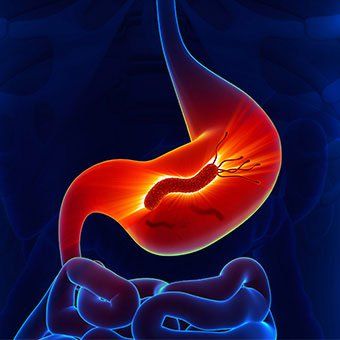This is an automatically translated article.
The article is professionally consulted by Master, Doctor Tran Thi Vuong - Doctor of Microbiology - Laboratory Department - Vinmec Hai Phong International General HospitalUrea breath test (UBT) is one of the simple, non-endoscopic methods that still allows the detection of H.pylori infection in patients. In particular, the C13 breathing test can be considered the "gold standard" for detecting and evaluating the effectiveness of HP treatment.
1. What is Helicobacter pylori?
H.pylori is a bacterium that not only causes gastritis, duodenitis and gastric ulcer in humans, but also causes gastric adenocarcinoma and lymphomas of the lymphoid tissue associated with mucosa-associated lymphoid tissue lymphomas (MALT).
Vi khuẩn HP là nguyên nhân gây ra các bệnh lý dạ dày
2. What is C13 breath test?
C13 breath test, also known as C13 urea breath test (13C-urea breath test: UBT) is a non-invasive technique, based on the principle that the patient will take 1 pill or 1 pill. A solution containing Urea with a carbon molecule isotope C13. If there is Hp in the stomach, Hp will produce urease and hydrolyze the urea in the oral medicine into Ammonia and Carbonic gas. Carbonic gas with this C13 or C14 molecule is absorbed into the blood and eliminated through the lungs. They will measure the amount of C13 or C14 released in the breath of the tester, thereby determining whether Hp bacteria are active (urease-producing) in the stomach.
When using urea C13 at a dose of 1 μCi (0.2 mL) mixed with 50 mL of citric acid for oral administration, a breath sample was taken before drinking and a breath sample was taken at 10-15 minutes after Drinking urea C13, CO2 generated will be measured by beta liquid scintillation machine. H.pylori infection detection results are assessed in terms of flashes per minute (cpm: counts per minute) as follows:
Values from 0 - <25 cpm are (-) counted: patient is not currently infected H. pylori. Values between 25-<50 cpm are undefined. A value > 50 cpm is (+) counted: the patient is currently infected with H.pylori. Three months after the course of antibiotic treatment for H.pylori, a urea breath test C13 is required: if the test is positive: the patient is still infected with H.pylori, the treatment has not been successful; if negative, the patient is no longer infected with H.pylori, treatment has been successful.
C13 breathing test is widely applied because of the following advantages: Fast detection of HP bacteria No need for endoscopic techniques, high sensitivity and specificity Easy to check after treatment Minimize risk of error sampling No radiation Simple and economical Can be used by pregnant women and children Time saving: 30 minutes to take 2 breath samples and 3 minutes to analyze results. High level of safety for patients and medical staff Disadvantages of breath test: Because the breath test method does not require gastroscopy, it can only check whether the tester is infected with Hp; rather than observing the lining of the esophagus, stomach and duodenum to assess inflammation and ulceration; Therefore, it is possible to miss the lesions of the upper gastrointestinal tract such as peptic ulcers, polyps and other types of tumors of the esophagus, stomach...
Therefore, this method is not usually indicated for subjects. have dangerous signs such as: vomiting or bloody stools, persistent stomach pain, abnormal weight loss, loss of appetite, loss of appetite, elderly people...
3. When is the C13 breath test indicated?
Urea C13 breath test may be ordered to screen patients with gastric disorders before endoscopy and to evaluate the effectiveness of treatment to rule out H.pylori:
Epigastric pain Bloating Ợ Sour indigestion Indigestion Nausea, ... Urea C13 breath test is also indicated after three months of treatment to evaluate the effectiveness of H.pylori eradication treatment with antibiotics without the need for gastroscopy to give birth. rapid urease test or other invasive tests.

Test hơi thở C13 khi bệnh nhân có dấu hiệu rối loạn dạ dày
4. Note when testing HP bacteria with breath
Note: Urea C13 breath test will not be accurate when:
Urea C13 breath test may be false positive if breath sample is taken within a short time < 10 minutes after taking urea C13. The urea C13 breath test may be falsely negative if the patient is taking antibiotics, bismuth salts, proton pump inhibitors (PPIs), or sucralfate. Patients need to stop taking these drugs at least 10 days before having a C13 breath test. The urea C13 breath test should be performed under fasting conditions, at least 4 hours after eating, preferably in the morning after a night of no food or drink. If you have a need for in-patient testing at Vinmec International General Hospital, you can contact Vinmec Health System nationwide or register online HERE.














